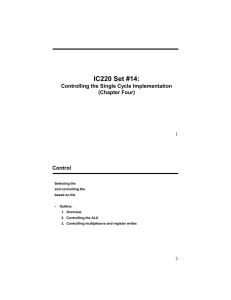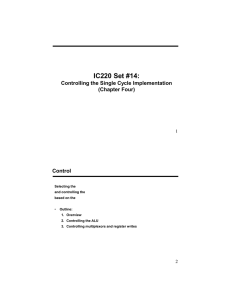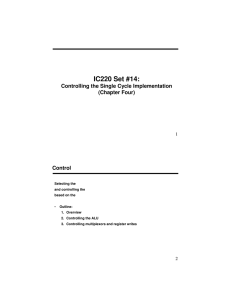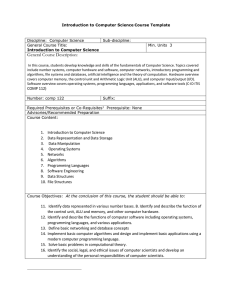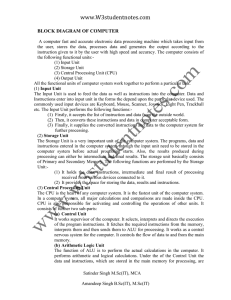IC220 Set #14: Controlling the Single Cycle Implementation (Chapter Four) Control
advertisement
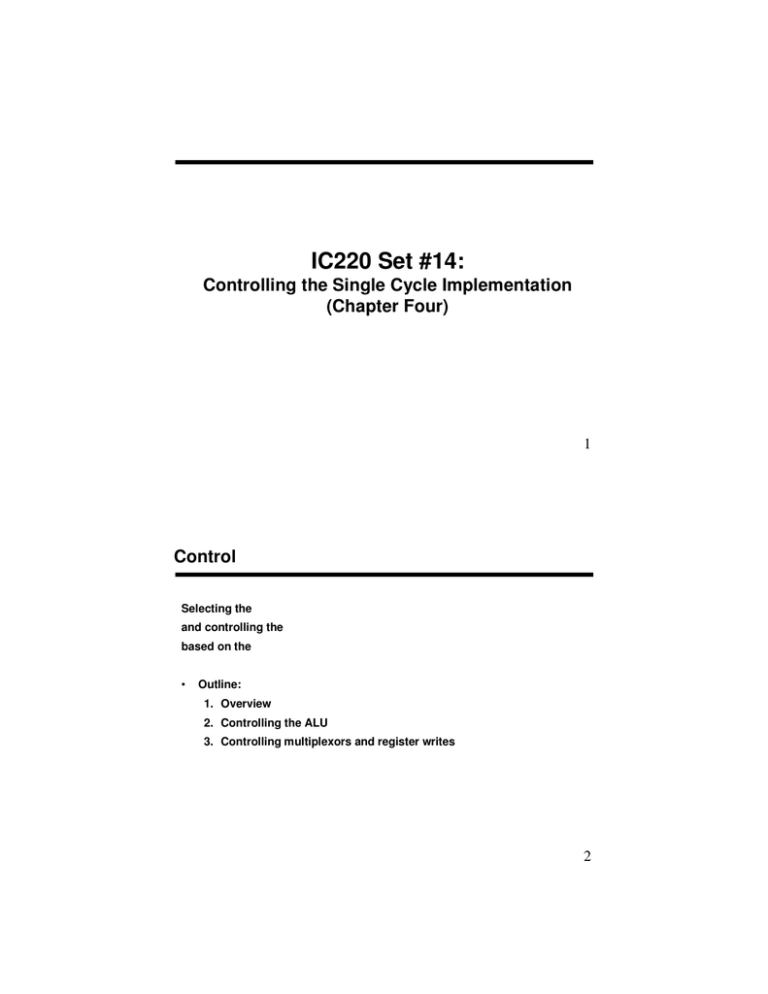
IC220 Set #14: Controlling the Single Cycle Implementation (Chapter Four) 1 Control Selecting the and controlling the based on the • Outline: 1. Overview 2. Controlling the ALU 3. Controlling multiplexors and register writes 2 Part 1: Control Overview Example #1: add $8, $17, $18 000000 10001 10010 op rs rt Example #2: lw $2, 12($1) 100011 00001 00010 op rs rt 01000 rd 00000 100000 shamt funct 0000000000001100 16 bit offset add $8, $17, $18 lw $1, 12($2) A. What should the register file do? B. What should the ALU do? C. What should the muxes do? 3 Part 1 – Control Overview 4 Recall: ALU Control and Symbol ALU Control Lines Function 0000 AND 0001 OR 0010 Add 0110 Subtract 0111 Set on less than 1100 NOR 5 Part 2: ALU Control Scheme Instruction OpCode Instruction op lw (35) load word 000000 sw (43) store word 000000 beq (4) branch equal 000000 R-type (0) add 100000 R-type (0) subtract 100010 R-type (0) AND 100100 R-type (0) OR 100101 R-type (0) Set on less than 101010 Funct Field Desired ALU action ALU control input 6 Part 2: ALU Control • Must describe hardware to compute 4-bit ALU control input given 1. Instruction type 00 = lw, sw 01 = beq, 10 = arithmetic 2. Function code (for arithmetic) • Describe it using a truth table: 7 Part 3: Main Control • • • Set the muxes and register write signals – To get data to flow to the right places – To store data in the appropriate places 7 signals: – ALUSrc – MemtoReg – MemRead – MemWrite – PCSrc – RegDst – RegWrite Control based on: 8 Part 3 – Main Control 9 Example – Main Control for an ‘add’ EX: 4-1 … 10 Adding Jump? (part 1 – dataflow) 11 Adding Jump? (part 2 – dataflow) To complete the jump instruction, modify the control chart below (add a new row and any new signals, if necessary). Instr RegDst ALUSrc MemtoReg RegWrite MemRead MemWrite Branch ALUOp1 ALUOp0 R-format 1 0 0 1 0 0 0 1 0 lw 0 1 1 1 1 0 0 0 0 sw X 1 X 0 0 1 0 0 0 beq X 0 X 0 0 0 1 0 1 12 Our Simple Control Structure • All of the logic is combinational • We wait for everything to settle down, and the right thing to be done – ALU might not produce “right answer” right away – we use write signals along with clock to determine when to write • Cycle time determined by length of the longest path State element 1 Combinational logic State element 2 Clock cycle We are ignoring some details like setup and hold times 13 Performance • Calculate cycle time assuming negligible delays except: Memory (200ps), ALU and adders (100ps), Register file access – read or write (50ps) 14 Performance Calculation Instruction Class Functional Units used by the instruction class R-type lw sw beq Memory (200ps) ALU and adders (100ps) Register file access – read or write (50ps) Final Cycle Time? 15 Performance – extra picture #1 • Calculate cycle time assuming negligible delays except: Memory (200ps), ALU and adders (100ps), Register file access – read or write (50ps) 16 Performance – extra picture #2 • Calculate cycle time assuming negligible delays except: Memory (200ps), ALU and adders (100ps), Register file access – read or write (50ps) 17 Performance – extra picture #3 • Calculate cycle time assuming negligible delays except: Memory (200ps), ALU and adders (100ps), Register file access – read or write (50ps) 18 Performance – extra picture #4 • Calculate cycle time assuming negligible delays except: Memory (200ps), ALU and adders (100ps), Register file access – read or write (50ps) 19 Evaluation – Single Cycle Approach • Good: • Bad: 20
